
Source: Shutterstock
Nova: a star showing a sudden large increase in brightness and then slowly returning to its original state
Supernova: a star that suddenly increases greatly in brightness because of a catastrophic explosion that ejects most of its mass
I recently wrote about reports on the documented decline of visitors to Twitter.com. A good friend encouraged me to take a deeper look at the reports as a way of discerning hype from reality and to also examine the potential trends that will most likely set the stage for something more meaningful.
At the very least, Twitter has been nothing short of a cultural catalyst that transformed how people communicate as well as how messages are distributed and disseminated. Twitter as a platform has also effectively served as the social OS for many of its loyal and enthusiastic users.
Over the last year, Twitter has experienced astronomical growth. Earlier this year, Nielsen reported that Twitter visits skyrocketed by a staggering 1,300 percent between February 2008 and February 2009. In April, the growth only accelerated as the now infamous Race to 1 million sent visits to Twitter soaring – attracting the media elite, celebrities, and their dedicated communities to the highly scrutinized conversation stream that served as the pulse for world events, shared observations, new ideas, common interests, and breaking trends. Twitter transformed into a human seismograph and through it, we feel everything that moves us. As such, Twitter itself achieved celebrity status.
But now, the Twitter star appears to be losing its luster – that is if you follow the increasing reports that continue to emerge. Without knowing better, one might believe that these reports circle the brand as if they symbolized a small but starved flock of new media vultures overly anticipating their next meal.
The truth is that yes, traffic at Twitter.com is down. Twitter co-founder Evan Williams recently acknowledged the down-trending activity at the recent Web 2.0 Summit in San Francisco, but vowed that it was a temporary phenomenon.
The problem with Twitter is upfront, not over time. We’re focused on solving the problem of what to do with Twitter now for the first time. We’re putting emphasis on mobile, international, and the platform. Traffic on Twitter.com has slowed temporarily.
But the scrutiny continues. eMarketer recently ran a rather convincing analysis that stacked-up data documenting Twitter’s recent decline in traffic.
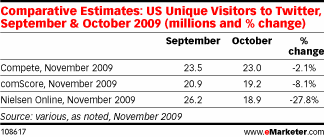 ,
,
Depending on the source, Twitter traffic is down as much as 27.8% between September and October 2009.
To verify, I also visited Compete and Alexa to capture charts that visualize current activity.
According to Compete, Twitter traffic has dropped over the last three months, with unique visitors and visits falling by just over 2% . Alexa wasn’t that much different.
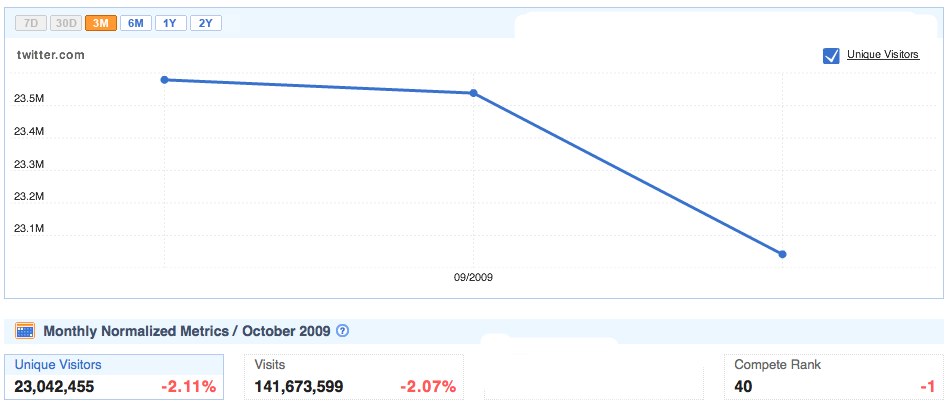
As eMarketer notes:
It has not been unusual to see wide shifts in Twitter traffic readings among Web measurement firms, and different methodologies likely account for the varying visitor counts. But one thing is clear: traffic to the Twitter.com Website is declining month over month after a period of huge gains.
There’s a debate however as too what this data truly represents. After all, Twitter users are the last people who want to hear that their beloved Twitter is losing brilliancy.
Many argue that experienced Twitter users are simply migrating to desktop and mobile applications to participate in the conversation stream.
With the help of Dan Zarrella, we documented that upwards of 41% of all tweets were sourced from Twitter.com with TweetDeck and UberTwitter following with a paltry 6.6% and 4.4% respectively.
We also know that there are at least 27.3 million tweets flying across Twitter each day.
eMarketer estimated in September that 18 million US adults would use Twitter by the end of 2009. And according to Senior analyst Debra Aho Williamson, “While it’s valuable to look at Twitter’s Web traffic, the true picture won’t emerge until all the third-party traffic from mobile phones and API clients is accounted for.”
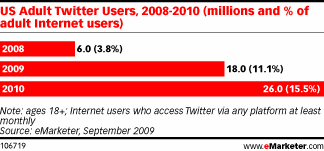
Data doesn’t lie. Traffic is down. Access is distributed. What has yet to enter the dialogue is the reality that traffic at Twitter.com represents so much more that those using it to follow or share updates.
Twitter.com is also the single destination where new users land to evaluate the viability of joining the flock.
Does a decrease in traffic also represent a recession in new user registration and retention?
In April, Nielsen released a study that observed over 60 percent of new Twitter users failed to return the following month, creating a retention rate of only 40 percent. Facebook and MySpace retention rates were twice as high during their phases of dramatic growth and only continued to escalate to the nearly 70 percent.
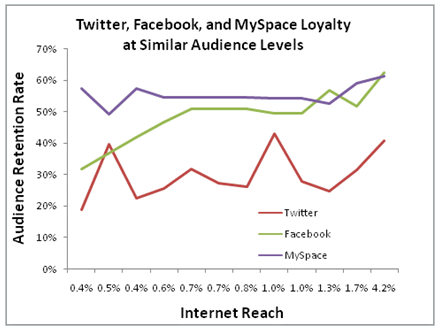
So what?
Perhaps Twitter just needs a little help crossing the chasm.
While on stage at Web 2.0 Summit, Evan Williams vowed to overturn the descending movement within the next few months. In just a few short weeks, Twitter rolled out a series of new features that enliven the experience at Twitter.com. With the release of Lists and List Widget services, people can now productively curate a more meaningful experience for themselves and others. The second announcement in the lineup of new features also included a friendlier framework for retweets to help unclutter the tweet stream. Twitter also included a caching service so that while the page is sitting idle, it counts how many tweets await a refresh.
It goes back even further however.
In July, Twitter redesigned its home page to give new visitors something new to provide a frame of reference, expectation setting, and also a lens into the conversations populating the pioneering micro cultural center. The introductory page also placed an emphasis on search, the very functionality that helped Twitter earn prominence among core users. The intention is to introduce new visitors to conversations that are related to the keywords that are important to them. As the site homepage now reads, “Share and discover what’s happening right now, anywhere in the world.”
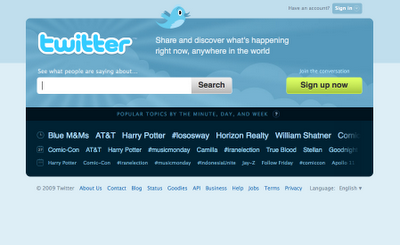
Also in July, Twitter rolled out an instructional 101 series designed to help users create a strategic and effective presence as well as spark and foster a collaborative community in the ever-maturing Twitterverse.
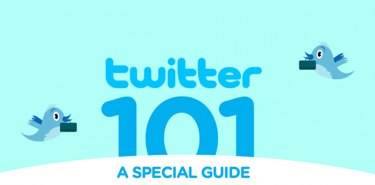
Co-Founder Biz Stone explained the rationale behind the creation of the guide,
Many are seeing a wide variety of businesses using Twitter in interesting ways to create value for customers and consumers. As a result, we’re often invited by businesses and organizations to talk about Twitter and how it can be used to better engage with customers. The results demonstrate how customers are getting value out of Twitter and suggest techniques businesses can employ to enhance that value.
To truly fathom the significance and meaning of visits to Twitter.com, we have to consider that the real growth opportunity for Twitter lies in its ability to attract AND retain new users. Twitter must complement its engineering efforts with experiential architecture to more effectively communicate its relevance and significance to new users.
The problem isn’t publicity.
Every day, millions of people are introduced to Twitter through traditional media, online chatter, and business marketing campaigns.
In July VMS, a media intelligence company that monitors news coverage on television, radio, newspapers, magazines, and the Internet, estimated that Twitter received $48 million of free media coverage in June 2009 alone. Online, Twitter received 2.73 billion impressions, with Television contributing to 57% of the PR value, newspapers 37%, and magazines 5%.
So where is everyone going?
If Twitter is truly to become the leading indicator for the “pulse of the planet,” perhaps it needs to go back to the beginning.
In these analyses, we can unearth not only the reasons for the declination, but also the necessary signals to reverse the trend. Everything starts with productive research that begets innovation in both features and experiences.
It’s as simple as asking the right question of its users to shape participation and extend conversations. As you may have recently noticed or heard, “What are you doing” is now “What’s Happening?”
It is a step in the right direction, but it is not nearly enough.
Remember, millions of prospects are introduced to Twitter daily and they’re each wondering just what it is, what to do and why, and what’s in it for them. When they hit the site to register, the words and images they encounter define whether or not they ultimately register and the initial people they follow determine whether or not they return and if so, how often and to what extent.
For mainstream users and also those within the early market majority, more can be done to share what they’re missing and also why Twitter would be a much better community with their participation.
Today, new users are offered very little enticement to join. In fact, most must decipher the following passages in order to understand why they should join, “Share and discover what’s happening right now, anywhere in the world” and “See what people are saying about…”
If they are so compelled, they can also click through to “about us.” But as you’ll see it’s not designed to lure members.
The real issue is tied to next steps. What do potential users need to do next? As such, the opportunities for shaping experiences unravel with every click.
Many of us have forgotten what it’s like to register, as our inspiration to do so was driven by other factors.
However, once someone clicks to “sign up”, the series of events only leads someone to the crux of the service without shaping or inspiring expectations and engagement.
Find Friends

Follow Notable Individuals
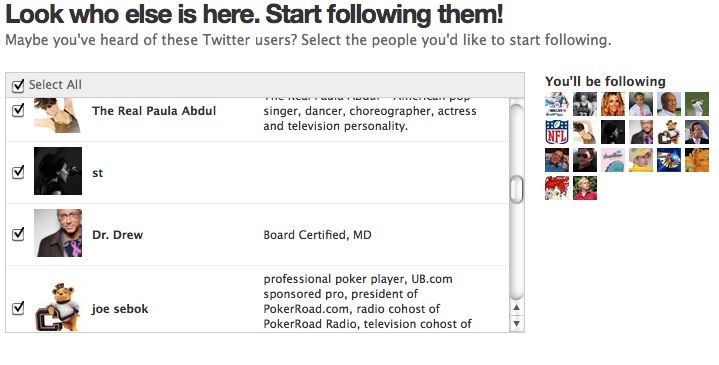
Tweet! Discover! Share!
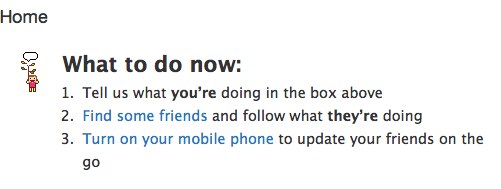
With a billion dollar valuation, Twitter possesses the wherewithal to employ talented and creative design services to introduce helpful features and content. In doing so, Twitter will handhold prospects through the discerning value of Twitter upon reaching Twitter.com and continuing through to registration and ultimately participation.
Twitter has amassed an incredibly loyal and enthusiastic community that is willing and ready to align behind a common vision to redesign the Twitter experience for those who’ve not yet encountered or embraced it. Above all, value and potential are in the eye of the beholder. Twitter can only benefit from assisting new visitors in understanding the promise and prospect of following and driving conversations on Twitter in order for it to truly become the pulse of the Web. In the process, Twitter will find that they quite literally invested in the enhancement and value that defines the overall experience for everyone in the process.
Connect with Brian Solis on:
Twitter, FriendFeed, LinkedIn, Tumblr, Plaxo, Posterous, or Facebook
—
Click the image below to buy the book/poster:
pr pr+2.0 pr2.0 public+relations marketing advertising interactive social+media socialmedia brian+solis social media media2.0 media+2.0 2.0 smo social+media+optimization marcom communication publicity advertising expert interactive spin brand branding guru social+architect







Brian, great post. Much of what you talk about was predicted via the Gartner Hype Cycle. This model predicted twitter's downward trend even before it had reached its peak. This downward trend, by the way, is a good thing as it signifies a continual path toward true value. If simply tweeting customer service needs, marketing dribble or benign information in small clusters of text is Twitters greatest value then it is doomed or will be dominated by some other technology which can truly benefit the needs of the user following its similar format.
My question to everyone using twitter is how can it be used better than simply standing on a mountain top and screaming in 140 characters hoping someone in the world is listening (yes, there is value re customer service but there are other similar tools which offer equal value). What I see most often now is its incorporation or evolution into childish toys for people to play with. Perhaps this is part of all technological evolutions.
How can we incorporate twitter to actually serving needs. How will it be incorporated into future technology such as NFC, etc. How do we factor in Dunbar's Law re size of community and Reed's Law regarding exponential value of multiple communities (I would argue Twitter's lists aren't the answer). These are the questions we need to be talking about. If we can answer those then the conversation about how many people tweeted today becomes mute because the value isn't in the numbers it's in the meeting of objectives.
I look forward to seeing Twitter evolve into a valuable tool which truly benefits its users.
Bill, I am a big fan of your views and I'm incredibly thankful for taking the time to share such a thoughtful comment with us. I couldn't agree more. In order for Twitter to grow, we have a responsibility to inject value as does Twitter. At the very least, I believe it starts with Twitter's ability to help us understand the potential and also set the stage for how we engage. Of course, the media isn't helping either. They broadcast, “Follow us on Twitter” but they don't say why – nor reinforce the value. They focus on customer service and thus condition online customers to take to Twitter to seek resolution or to score exclusive deals/offers. Now, they're focusing on the paid aspects of tweets. There's so much more to Twitter than we realize, but someone has to become the champion and it starts with Twitter – not everything can be open source, at least not without direction and inspiration.
I'm thinking that Twitter's visitor count will drop to its pre-media coverage boom and then slowly start to build up again, if it's lucky. A lot of people don't really see a use for it (I'm not a hater – I think it's great – but I am pragmatic) and it seems to have become a spot where marketers and self-promoters speak at each other instead of having a conversation.
Facebook essentially offers the same thing with status updates – the only difference with Facebook is that 250 million people use it and it can do a host of other things that don't require additional URLs (bit.ly, twitpic, etc.).
I think this is unfolding as we type…
I'm on Facebook as well as Twitter. Facebook appeals to normal people because it has pictures and other things from their real-life friends. Twitter, to me, is now turning into an aggregator which is something that Facebook just can't do. For instance, can you do this on Facebook: http://twitter.com/Scobleizer/tech-news-brands (put 500 tech news brands onto one page?) No way!
I like the lists feature, but why would the average person want to follow 500 tech brands? I use the list feature to pare handles down into manageable groups – friends and riffraff (I mean that endearingly). Some things I need to know immediately (coworker late for function), but I generally ignore riffraff unless I have more than a few minutes to browse through it all (Ochocinco is blowing up my feed!)
Great post, Brian.
As with most things Twitter, the eMarketer team had a spirited debate at the office as to what the numbers behind our Data Stacks Up on Twitter Decline story actually meant. There's no question that the data from Compete, Nielsen and comScore doesn't reflect the number of total tweets and therefore overall usage of the service. If we're to believe your work with Dan Zarrella, and I do, Twitter use is probably as high as it ever thanks to 3rd party/mobile apps. (TweetStats also has data to back up this claim). The other key question about the data was brought up by one of our readers: Maybe Twitter is finally cleaning up its spam mess.
Now, does spam count for a quarter of Twitter's web traffic? I don't know. But it's interesting to think about.
Still, I completely agree that the data does not bode well for how Twitter entices and keep new users. Like you said, “value and potential are in the eye of the beholder.” Twitter's new question, “What's Happening,” is a start from the messaging point of view, but it's still not going to convince outsiders who still view it as a “What's for breakfast” blogging service. I too look forward to the day when Twitter can better articulate its own value to prospective users. Currently I see people using it for news, customer service, intra-personal communication, marketing, gossip and more — but we're still a long ways from “pulse of the planet.”
Clark, well stated. Keep up the great work!
Great and thoughtful post, Brian. I ask myself these questions about Twitter every day, as most of my non-Geek friends on Facebook are drowned in my Twitter stream and wonder why I do things like say where I am (Foursquare). The don't see any reason to use Twitter, and question whether anyone cares what they had for lunch. There has been no serious MSM discussion of Twitter as search, Twitter as discovery, or Twitter as marketing tool — all of which preoccupy our community. The phrase “real time stream” scares the pants off people, as evidenced by what happens every time FB moves another step toward real time. What we find interesting, others may find annoying.
And now, Twitter is thinking of using advertising, and Ad.ly is using advertising already. Oy-vay.
But Twitter MUST cross the chasm. I believe it will end up being just another tool in a social network one day, as the Laconica platform suggests. At the end of the day, although world-changing, Twitter is a tool, not a product. It's a GREAT tool for some people, and a terrible tool for others. Example: Scoble hits the wall and goes down to 1500 follow-ees. Then he tries to segment by lists. And he's an uber-geek who gets paid to do this. His wife never sees him:-) [love you robert]
Hardaway is an uber-listener and a fast follower. So when Scoble makes lists, she makes lists. Her lists are crap. They don't contain half the good people Scoble's do. Every list she has, be it health care, politics, tech — is incomplete. So she follows Scoble's list, Palafo's list, Enoch Choi's list. Then she doesn't have time to look at her lists, and when she does, it's only to poke a toe into the latest flow of the river. She has no idea what has been happening all week, or even all day or all hour. The lists give here a glimpse of the last five minutes of ONLY the news on Palafo's list (which is often repetitive, because it's breaking news), or Scoble's list (always repetitive because geeks operate in memes).
See where I'm going with this? I'm a Twitterholic, with four accounts (me, my entrepreneurship, my health care interests, and my dog). I've invested a huge amount of time in Twitter, both for making friends (that's where it shines, but that part's going away as it grows) and for learning things. Ordinary people with real lives and families don't have time to study real time streams and Twitter apps and lists. And long-time users hardly every see their earlier Twitter-buds anymore. @newmediajim, susanreyolds, sheilas, preppydude, and many of my long-time Twitter friends are washed under by the stream, even though I still follow them.
Conclusion: Twitter is more difficult than we think. It's not easy to adopt, especially if you are going to do more than just broadcast, which is what most celebs do. It has an unwritten etiquette, which often grabs newbies by surprise, and now it's full of marketers and spammers. All the above is difficult to capture in statistics and algorithms, but I think that's what is happening.
Hmmm…I've written you a blog post! Thanks, friend.
Francine, you my friend, are both wonderful and brilliant. You have articulated concisely and humanly what others cannot. I think we need to promote this comment as its own post. Well done…oh, and I miss you! 🙂
I did write a post about it on Posterous.
Sharing here for everyone: http://stealthmode.posterous.com/twitter-advert…
Yup, Francine, you understand this stuff at a level most don't. Also, I've spent years building my lists, one reason I love lists is you can steal mine and take advantage of all the knowledge of the people on them that I've built up over the years.
“Ordinary people with real lives and families don't have time to study real time streams and Twitter apps and lists.”
That's exactly why Twitter doesn't offer much to people beyond current users. It's useful if you are in marketing and media, but if your job doesn't require that you monitor Twitter, and you are trying to juggle that and/or a family, you simply don't have time to be checking Twitter. Things come and go so quickly on Tiwtter that you've missed them.
If you want to communicate with people, email, phone, in-person, text, and chat get the job done.
I know a lot of people who use Facebook. In contrast to Twitter, it works for them because it allows them to catch up WHEN they have time, which is often later in the evening after their kids have gone to bed. Twitter, on the other hand, demands real time attention, as if any of us really wants one more thing demanding that we pay attention to it.
Does a decline in web traffic really mean a decline in Twitter? I'm a very early Twitter adopter, and still an active user, but I hardly ever show up at twitter.com. I'm using Tweetie as both a desktop and iPhone client. Most of the folks I know are using various other cients as well. Is anyone reporting on overall twitter traffic regardless of origin?
Michael, twitter traffic is interesting as it's only truly measurable at twitter.com and through the volume of tweets. Client data is only now starting to come together…what is clear, is that visitors to Twitter.com is down (hopefully temporarily) as existing users migrate to desktop and mobile clients and news users potentially subside – unsure of how to embrace twitter as a service and lifestyle.
Keeping in line with your Nova or Supernova analogy, I think twitter along with other social media is more likely to be in some type of time warp continuum with worm holes leading us to new and uncharted territories. I think we have to understand what these platforms are providing for the individual using it, and is it 'Taking us to the destination we were hoping'.
If most people are using social media to be just social then perhaps Twitter is not that platform to lend itself to the average person who hears about it and gives it a one day try and comes to to quick conclusion that 140 characters is not exactly allowing them to connect they way they have been used to on Facebook or Myspace. How are the supposed to share the 100 photo's they snapped off at the weekend on their cell phones with buddies.
If you follow the elite on Twitter with the 50,000 + followers they themselves still seem to be talking about social media as a subject platform to tweet about, and are still trying to get a handle on it as a resource in many ways. The celebrities of the world with the 500,000 + followers well they are providing the world with a star to direct your communication and fantasies at.
Can businesses use Twitter to add a ROI for themselves utilizing strategies integrated with other mediums perhaps yes I believe they can, but in a world of people who are not wanting to be directly sold on anything anymore.
Everything at this time seems to be in a universe of constant social media flux, as long as we continue to open up to the idea of discovering new conversations, I think we can learn and benefit from boldly going where a lot of us may not have ventured before, and get to interact with a world outside of our normal comfort zone.
Love the site! Thought you and your readers would like to check out the first Ladies' Home Journal 'Do Good' Stamp Winners for our upcoming December/January issue. To receive the Stamp, a company’s charitable works must involve its consumers and employees, be innovative and achieve results.
Please visit http://www.lhj.com/volunteering/companies-that-… to check out who made the list!
Seems so simple. Maybe too simple. The more you do ON/WITH twitter, the more you need a 3rd party app to manage it…
Now…with the things like lists and the new RT function on the Twitter.com UI we come back to investigate..then the 3rd party apps/tools integrate and we go away again…
So..if Twitter.com can't keep our eyeballs continually while we tweet, they must have lots of interesting other ways to make money that are not reliant on us “looking” at Twitter.com. I can't wait to see how all that evolves.
Your posts are always so great. You're one of my favorites. I just wanted to put in some simple points.
xo.
Twitter has changed as it's audience percentage wise changed. Twitter was used for the social media avant guard. It was about conversation and news, new and interesting connections and a new way of looking at things faster (140 character).
Today Twitter has two problems:
1) It became a new kind of classified listing – even if you take a lot of time weeding out your connections. The millions who join can't deal with it and no longer recommend it. Social Media is based on recommendations. Twitter risks to loose it.
2) The technology didn't evolve. It is still the sick piece of code that fails every hour and changes under your fingers. In a rating I'd rate it as the worst in software quality ever built. Even worst than Friendster in the past before it ended in mediocrity.
However I still tweet every day – hoping the twitter gang is listening and learning.
Axel
http://xeesm.com/AxelS
Brian, a well-researched and thought provoking post as always! I was still half asleep when I tweeted about it this morning, and chose my words poorly…my bad. Hopefully I can clarify my thinking a bit.
You are right on the money in pointing out that one piece of the puzzle not often discussed is the initiation experience for new users (from awareness through signup and into initial engagement). Twitter has a tremendous opportunity to enhance its “experiential architecture” here. Given that this experience has always been anemic on Twitter, though, I was just wondering why this would be a big driver of a downturn in traffic now.
Has the early adopter crowd ignored a bad initial user experience, and now we're hitting the chasm (as you mention)? Or is this a period of abandonment to be followed by a resurgence (a la TechCrunch's curiosity, abandonment, addiction model)? Are other channels and touchpoints stealing Twitter.com thunder more than numbers show? Lots of pieces in the puzzle.
One of the great challenges Twitter faces is that their brand and user experience are spread across many touchpoints over which they have no control. While this has worked to their advantage in terms of driving adoption, it does raise questions about their core product and how one evaluates it. Is their core twitter.com, and does traffic there measure success? Is API usage a better metric? Or is it a mix of these and possibly other factors?
It's going to be interesting to watch things continue to evolve!!
Retaining new users has always been a challenge via Twitter. When someone starts they do not know how to obtain followers and who to follow. The benefit to Twitter is the ability to meet new friends (unlike Facebook which is more for the friends I already know). When many of us started on Twitter you could follow the stream of all users and easily identify people to start following. It was also easy to start in the conversation and be noticed. Today we need to emphasize the benefits of search to these new user so they can find people with like interests.
The other problem that we as a community need to find ways to control is the amount of spam in the space. Even trending topics over the past 3-6 months have been filled with spam. Twitter is a great open discussion, but by allowing the spam it is really filled with a lot of noise that make it hard for the new user to understand. Some may say that it is up to Twitter to find resolution to this problem, but I think it also falls onto all of us. By alleviating this pain, the community would be better connected to each other.
Frank, well said. Filtering is right around the corner, I believe that will have a positive impact on the experience. Like you say, there's the experience once you're in and the experience to get you in…both need refinement and focus. Also, I think your post was extremely poignant (sharing here): http://www.eliasonfamily.info/blog/?p=882
Hey there,
A great post and several fantastic responses. I'm not as academically supported as some of the contributors here, but I can't help but feel that we've been here before. Email. Mobile phones. We didnt need any of them. Life revolved without them. Now – all of us with few exceptuions – have a set pattern of usage and cannot do without either a mobile phone or email. They are cemented into our vernacular.
Twitter fills a gap between social, real time, text (email) and format (sms). It's a natural evolutionary development of the Internet, and worthy of discussion, but the question eveloves in two directions. 1. What is the future of the brand “Twitter” when it's current and future development lies in the hands of peripheral brands and API integrators? and 2. What is the future of the real-time micro-blogging format?
The brand Twitter might be in decline – or not. It depends what you're measuring. Like many Twitter API driven apps, World of Warcraft and other “social”, Internet-based MMORPGs etc. cannot easily be measured by Nielsens, Comscore or Hitwise – does that mean they don't exist? Far from it.
I don't think I'm saying anything new, perhaps just paraphrasing in my own words, but I am more interested in the second question. I believe the “microblogging” format will stick in some format or another. Who remembers the first brand to develop email or the mobile phone?
Keep up the good work.
peace. aa
Really well done post, Brian. I admire how you tie in real analysis with speculation and make sense of it all. One point I continue to harp on recently is the idea that quantity is great, but doesn't mean much without true engagement. While it's easy to freak out over a drop in numbers, it's important to tie back what this means to individual goals. And I totally agree that some of this is about “asking the right question.” Thanks for sharing!
Interesting article, Thanks for sharing all your good work. I've recently found the conversations on Twitterto be far less personal than before. More 1-way statements —and fewer 2 -way conversations. Breaking through the white noise is becoming much more difficult—and talking to “logos” is not as interesting. Ski season in Aspen starts tomorrow—i'll probably tweet less / ski more.
This is off-topic for me, but some days ago I have posted about Twitter's future after attending an event with more than 100 travel bloggers, where I actually “saw the light”.
The current Twitter is not for mass market and it has to plateau way below Facebook in terms of users. This is not a problem per se – it depends on Twitter's strategy to make money.
http://eurostarclient.com/2009/11/13/twitter-ag…
Very interesting post and reader comments, Brian.
Twitter might have reached a step. But it is definitely not in decline. Twitter is the future, because it is about real- time signal processing. More on that here: http://harryseldon.thinkosphere.com/2009/06/14/…
I'm curious also how the interconnectedness of simultaneous posting between Twitter and Facebook, myspace, and most recently LinkedIn plays into all of this. It would also be really interesting also to see if the stream of Twitter information is getting larger.
I'm curious also how the interconnectedness of simultaneous posting between Twitter and Facebook, myspace, and most recently LinkedIn plays into all of this. It would also be really interesting also to see if the stream of Twitter information is getting larger.
“Ordinary people with real lives and families don't have time to study real time streams and Twitter apps and lists.”
That's exactly why Twitter doesn't offer much to people beyond current users. It's useful if you are in marketing and media, but if your job doesn't require that you monitor Twitter, and you are trying to juggle that and/or a family, you simply don't have time to be checking Twitter. Things come and go so quickly on Tiwtter that you've missed them.
If you want to communicate with people, email, phone, in-person, text, and chat get the job done.
I know a lot of people who use Facebook. In contrast to Twitter, it works for them because it allows them to catch up WHEN they have time, which is often later in the evening after their kids have gone to bed. Twitter, on the other hand, demands real time attention, as if any of us really wants one more thing demanding that we pay attention to it.
I really like this type of Shoes too, can you help me look at which
ugg boots
http://www.boots-outlet.us
ugg gissella boots
http://www.uggs-outlet-store.com/ugg-gissella-b…
ugg elsey boots
http://www.uggs-outlet-store.com/ugg-elsey-boot…
nike dunk
http://www.discount-nike-dunk-shoes.com
ugg classic tall stripe cable knit boots
http://www.uggs-outlet-store.com/ugg-classic-ta…
ugg boots outlet
http://www.uggs-outlet-store.com
winter boots
http://www.bootsforcheap.us
coach boots
http://www.discount-coach-outlet.com/coach-boot…
coach leather
http://www.discount-coach-outlet.com/coach-leat…
Nike Dunk mid
http://www.discount-nike-dunk-shoes.com/Nike-Du…
ugg boots
http://www.bootsforcheap.us
Normally I do not learn article on blogs, however I wish to say that this write-up very compelled me to try and do so!
Your writing style has been surprised me. Thank you, very nice
post.
of course like your web site but you have to test
the spelling on several of your posts. Many of them are rife with spelling issues and I
in finding it very troublesome to tell the reality however I’ll surely come back again.
Mirek Klabal likes to have big friends and family gatherings at his house in Greenwich.
He feels as though it is his obligation to host them. There are some real estate agents in Vaughan that work both for
sellers and buyers.
When a patient visit a qualified dentist for an implants, the dentist as a professional
first of all access and determine whether the patients
mouth is suitable to hold the implant in place.
The various reasons for loss of teeth include accidents, tooth decay, gum diseases, or
birth defects. Each raw material contributes a certain property such as dry strength, plasticity, shrinkage, etc.
Oh my goodness! Impressive article dude! Many thanks, However I am encountering issues with your RSS.
I don?t know the reason why I can’t subscribe to it. Is there anyone else getting the same RSS problems?
Anyone that knows the solution can you kindly respond? Thanks!!